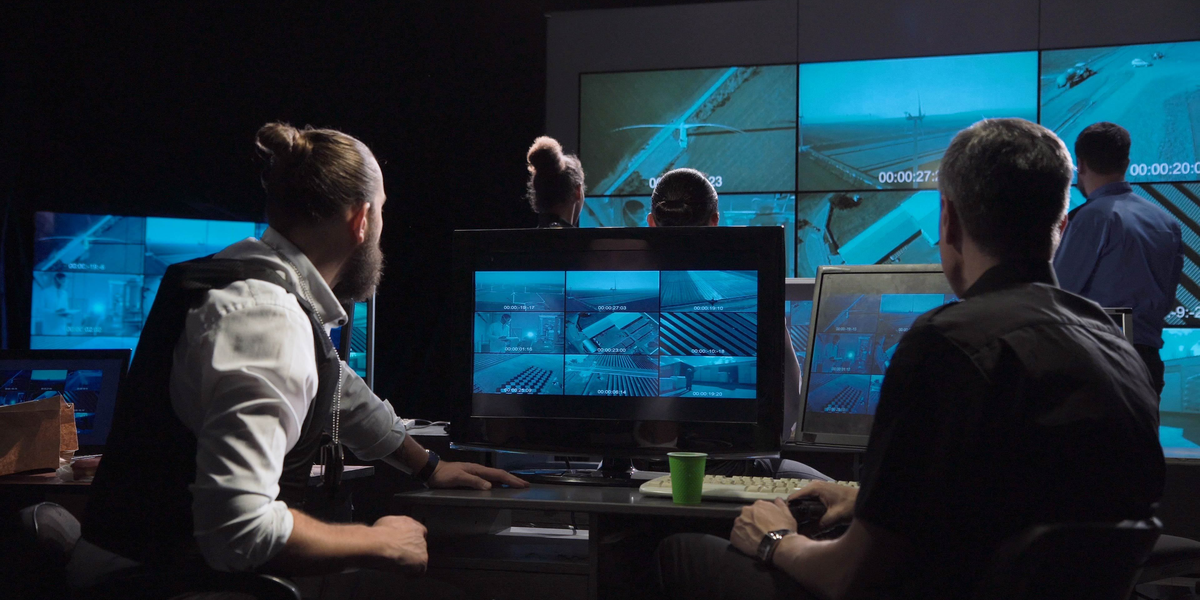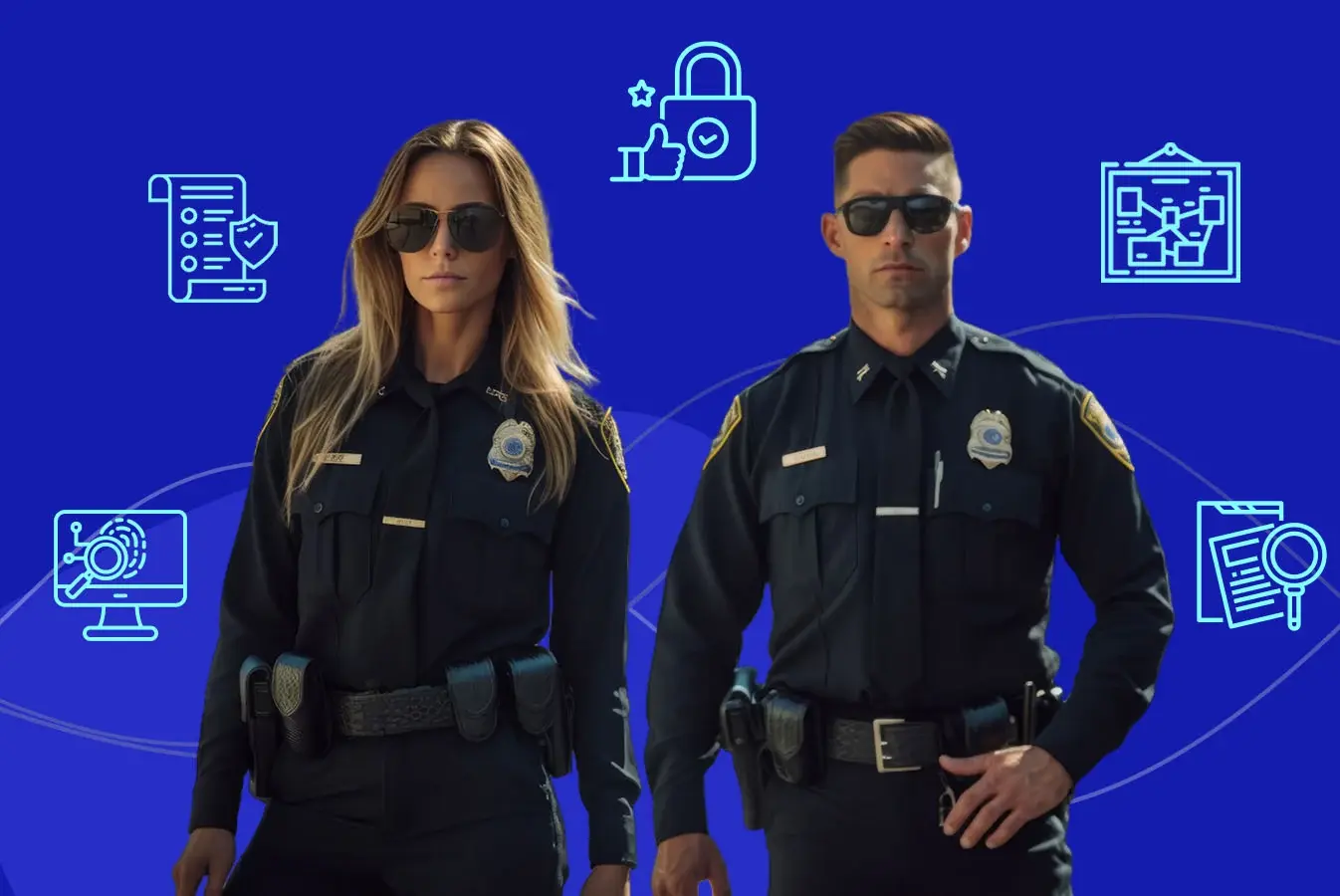The Rise of Dashcams: How Front and Rear Cameras Improve Car Safety and Evidence Collection
by VIDIZMO Team, Last updated: March 5, 2025, Code:

Dashcams are transforming road safety, offering video evidence for insurance claims, accident disputes, and law enforcement investigations. Learn how digital evidence management systems help securely store, analyze, and manage dashcam recordings for maximum efficiency.
Dashcams have rapidly become a must-have tool for drivers, law enforcement, and insurance companies, offering undeniable video evidence in accidents, disputes, and legal cases. According to an IACP study, 51% of drivers admitted they would change their behavior if they knew they were being recorded, while over 1,500 officers agreed that dashcams help prevent confrontational situations on the road.
With the rise in insurance fraud, reckless driving, and legal disputes, installing front and rear dashcams ensures video documentation of road incidents, making it easier to determine fault, resolve claims, and enhance public safety. Law enforcement agencies and insurance providers increasingly rely on dashcam footage as evidence to investigate crashes, issue citations, and exonerate innocent parties.
However, as dashcam usage grows, so does the challenge of managing large volumes of video recordings. This article explores the benefits of dashcams for drivers, insurers, and law enforcement while highlighting how a digital evidence management system can help securely store, analyze, and manage dashcam footage efficiently.
Importance of Dash Cams
Let's analyze the top 10 reasons why having dash cams is almost essential in 2025:
- Accountability becomes easier: In case of accidents, dash cams can prove crucial in providing assurance via evidence, especially if the person at fault tries to blame the victim. When the drivers know that they are being recorded, their vigilance will increase leading to safer and smarter driving habits.
- Makes insurance-related work easier: Complimenting the above point, it is easy to claim insurance when you catch accidents on film. Additionally, insurance companies also incentivize the usage of dash cams. In a survey of 2000 people, 20% claimed they installed dash cams to save on the cost of their car insurance.
- Budgetary challenges: Dashcams allow officers access to digital evidence, which will enable them to secure a conviction. Consequently, the effectiveness and importance of police departments increase, allowing the growing budgetary challenges to be tackled.
- Relief for the officers: Dashcams and in-car camera systems serve as an additional voice for the officers, allowing the recordings to do the talking for them. According to an IACP study, dashcams have helped exonerate wrongly accused police officers 93% of the time a complaint has been filed against them.
- Fewer complaints: According to a study by the International Association of Chiefs of Police (IACP), in-car video systems reduce the number of false complaints registered by members of the public as there is a lesser chance for any discrepancy. When being filmed via either front or rear dash cams, both the police and the public remain civilized, leading to a reduction in tensions between the police and the public.
- Increase in operational efficiency: Dashcams assist in the case of vehicle breakdowns. With advanced dash cams and 4G wireless connectivity, vehicle telematics data such as engine speed and tire pressures can be shared with law enforcement agencies in real-time.
Dashcams can also transfer real-time video both from the front and rear of the police vehicle, which serve as important digital evidence that could be instantly transferred to the police headquarters. - Improves conviction rates: The usage of dashcams has increased the conviction rate for most cases. It is difficult to build a clear perception of the event from officers’ verbal description of the incident. In contrast, the video recordings help paint a better picture of the event and serve as valuable digital evidence. In the IACP study already mentioned above, it was concluded that 93 percent of prosecutors rated the usage of video evidence in court as a success.
- Improves car safety: When the cars are parked, dashcams can be set to detect motion around cars which can record break-ins, acts of vandalism and hit-and-run incidents. It becomes less of a worry when you have front and rear dashcams installed which will record videos which could serve as potential evidence in case of a mishap when your car is parked.
- Improves road safety: Dashcams help in improving road safety for drivers and pedestrians. Having a front and rear dashcam installed, you can rest assure that you will not be a part of traffic scam fraud. In certain countries, fraudsters try to throw themselves in front of vehicles and demand the driver to pay for the fake injuries. Not only can you catch such scammers red-handed, but you can also ensure such acts come to a stop, thus improving road safety.
- Makes you a better driver: Imagine viewing your driving skills (or the lack of them) when you re-watch footage of you driving on a busy highway. Dashcams are the best way to improve your presence behind the wheel.
Aware of the proper usage of dash cams?
Perhaps not as important as the privacy and security aspects of front and rear dash cams, users still need to be aware of the following elements:
- The dashcam must be correctly fitted to be admissible in court for the digital evidence recorded from dash cams.
- The appropriate location for the front dash cam is behind the rear-view mirror as its central location allows a clear vision of the roads and the lanes ahead.
- A rear dash cam needs to be bonded to the top-center part of the rear windshield using an adhesive mount.
- Footage should absolutely not be tampered with! Deleting or editing footage that potentially contains incriminating evidence is a serious offense.
How Insurance Companies & Law Enforcement Use Dashcams
Dashcams have multiple use cases in various departments, but when it comes to the collection of digital evidence, the organizations that benefit most from the use of dashcams are Insurance Companies and Law Enforcement agencies. Below we discuss how dashcams help the insurance and law enforcement agencies.
How Insurance Companies Benefit from Dashcam Footage
Insurance companies are increasingly recognizing dashcam footage as critical evidence in accident claims. When a dispute arises over fault, using dashcams as evidence helps insurers determine liability quickly and fairly. A recorded video eliminates "he said, she said" scenarios, reducing fraudulent claims and ensuring the rightful party receives compensation.
In fact, some insurers now offer policy discounts to drivers who install dashcams. This is because vehicles equipped with front and rear dashcams are less likely to be involved in staged accidents or fraudulent insurance scams. According to industry reports, insurance fraud—especially staged accidents—costs billions annually. With dashcam footage serving as undeniable proof, insurance companies can reject fraudulent claims and streamline the claims process, saving both time and money.
Moreover, advanced dashcams with cloud storage and real-time connectivity provide even more value. Some insurance companies now partner with dashcam manufacturers to automatically upload crash footage to their systems, speeding up claim investigations. This level of integration is revolutionizing the way digital evidence management systems handle insurance claims.
The Role of Dashcams in Law Enforcement and Public Safety
For law enforcement agencies, dashcams have become an essential tool for investigations, traffic monitoring, and ensuring public safety. Whether installed in patrol vehicles or used as civilian footage, dashcam video evidence helps officers reconstruct accidents, verify events, and improve accountability.
One of the primary advantages of using dashcams as evidence in law enforcement is the ability to accurately document roadside interactions. This benefits both officers and civilians by creating a transparent record of encounters.
Beyond traffic stops, dashcams play a crucial role in criminal investigations. For example, hit-and-run cases often rely on dashcam video analysis to identify suspect vehicles. Law enforcement also uses AI-powered digital evidence management systems to efficiently store, organize, and analyze dashcam recordings. Features such as automatic redaction, facial recognition, and secure evidence sharing help officers manage large volumes of dashcam footage while maintaining legal compliance.
With growing concerns around data security and evidence integrity, law enforcement agencies must use secure cloud-based storage solutions to ensure that dashcam evidence remains untampered and accessible when needed.
The Privacy Challenge Associated with Dash Cams
The images and videos of a person recorded via a dashcam is considered personal data under General Data Protection Regulation (GDPR). Usage of a dashcam, especially if both a front and a rear one is used, will record an image of a person, which is considered personal data under GPPR. According to Data Guidance, anyone using a dashcam needs to make sure the following points are adhered to:
- There is a specific purpose for the use of personal data recorded via a front or rear dashcam, keeping the lawful basis for collecting and processing of personal data in mind.
- Make sure the recorded material is securely stored, and only relevant personnel have the right to access the data from it.
- Make sure the data retention policies are followed.
- Footage should not be published on social media platforms as it infringes on the privacy rights of pedestrians, drivers and other personnel captured on recordings.
- The recording should be adequately redacted before sharing in order to comply with regulatory frameworks that govern privacy.
Overcoming Storage Challenges with Dashcams
The technology behind front and rear dashcams has significantly advanced in 2025, enabling vehicles to capture high-quality footage for evidence and security purposes. Most modern dashcams record in Full HD (1080p) at up to 50 frames per second, while some high-end models even support 4K recording. Features like High Dynamic Recording (HDR) and infrared LEDs enhance night vision, ensuring clear footage in all conditions.
However, storing vast amounts of dashcam recordings remains a major challenge, especially for organizations such as law enforcement agencies, insurance companies, and fleet operators that rely on video evidence for investigations and claims processing.
The Problem with Traditional Dashcam Storage
Dashcams typically store recordings on SD cards, which come with significant limitations:
- Limited Capacity: SD cards fill up quickly, especially with high-resolution recordings, leading to frequent overwriting of crucial footage.
- Risk of Loss or Theft: If the dashcam or SD card is stolen or damaged in an accident, all evidence is lost.
- Manual File Transfers: Retrieving footage requires physically removing the SD card and manually transferring files, which is time-consuming and inefficient.
- Compliance and Security Issues: Storing and managing video evidence must comply with chain of custody protocols, retention policies, and data security regulations—something SD cards fail to address.
For police departments, patrol vehicles generate hours of dashcam footage daily, which creates a massive burden on storage infrastructure. Without an efficient digital evidence management system, handling such volumes of data becomes impractical.
The Solution: Using Digital Evidence Management System
To overcome these challenges, digital evidence management systems now support automated ingestion and cloud-based storage for dashcam footage, ensuring that recordings are securely stored, easily accessible, and tamper-proof.
Key advantages of using cloud based digital evidence management storage for dashcam recordings:
- Automatic Ingestion: Dashcams can be integrated with a digital evidence management system that automatically ingest video footage to a secure cloud or on-premises storage system. This eliminates the need for manual file transfers.
- Unlimited Storage and Scalability: Cloud-based digital evidence management solutions allow for scalable storage, ensuring that no critical footage is lost due to space limitations.
- Data Integrity and Compliance: Video evidence is protected with encryption, access controls, and audit trails, ensuring compliance with legal and regulatory requirements in a digital evidence management system.
- Secure Access and Sharing: Authorized users, such as investigators, insurance adjusters, and law enforcement officers, can securely access, analyze, and share footage without compromising evidence integrity.
- Redundancy and Backup: Unlike SD cards that can be lost or damaged, cloud storage ensures footage is automatically backed up, preventing data loss in case of theft, accidents, or hardware failures.
By leveraging a dedicated digital evidence management system, organizations can efficiently ingest, store, manage, and analyze dashcam footage, ensuring that video evidence remains secure, searchable, and admissible in court.
This shift from local storage to cloud-based digital evidence management is revolutionizing how dashcam footage is handled, making it easier to protect and utilize critical video evidence for investigations, insurance claims, and legal proceedings.
Solving Dashcam Storage & Evidence Management Challenges with VIDIZMO
Managing large volumes of dashcam footage can be overwhelming, especially for law enforcement, insurance companies, and organizations relying on video evidence. VIDIZMO Digital Evidence Management System (DEMS) provides a secure, scalable, and AI-powered solution to automatically ingest, store, analyze, and manage dashcam recordings without manual intervention.
With automated ingestion, VIDIZMO DEMS seamlessly uploads footage from front and rear dashcams to a secure cloud or on-premises system, ensuring evidence is immediately available, tamper-proof, and compliant with legal regulations like CJIS, GDPR, and FedRAMP. AI-powered features enable facial recognition, object detection, and automated redaction, making it easier to search, analyze, and share footage securely with authorized personnel.
VIDIZMO DEMS offers flexible cloud deployment options, including Microsoft Azure, AWS GovCloud, and private cloud solutions, allowing organizations to choose the best storage environment for their needs. Whether for law enforcement investigations, insurance claims, or fleet management, VIDIZMO DEMS provides an end-to-end solution for efficiently handling and utilizing dashcam video evidence.
The Future of Dashcams and Digital Evidence Management
Dashcams are no longer just optional accessories—they have become essential tools for road safety, legal protection, and digital evidence collection. As their adoption continues to rise, insurers, law enforcement agencies, and fleet operators are increasingly relying on dashcam footage as evidence to resolve disputes, enhance security, and improve accountability.
However, the challenge lies in efficiently managing, storing, and analyzing the vast amount of high-resolution dashcam recordings being generated daily. Traditional storage methods, like SD cards, are unreliable and inefficient, making cloud-based digital evidence management systems a necessity for organizations handling video evidence.
With advancements in AI-powered video analysis, automated redaction, and secure cloud storage, organizations can now ingest, store, and process dashcam footage seamlessly. This ensures that critical evidence remains accessible, tamper-proof, and compliant with legal and regulatory standards.
To make the most of your dashcam recordings, you need a secure, scalable, and AI-powered digital evidence management solution. With VIDIZMO DEMS, you can automatically ingest, store, and analyze video evidence while ensuring compliance and security. Start managing your dashcam footage efficiently today! Sign up for a 7-day free trial today!
People Also Ask
Why are more people installing dashcams in their cars?
More drivers are using dashcams for video evidence in accidents, preventing fraud, and improving road safety. They help with insurance claims and law enforcement investigations.
Can dashcam footage be used as legal evidence?
Yes, dashcam footage is admissible in court and is often used in accident disputes, insurance claims, and law enforcement cases to determine liability.
Do insurance companies accept dashcam footage for claims?
Many insurance companies accept dashcam videos as evidence to verify accident details, prevent fraudulent claims, and may even offer premium discounts for having one.
What are the storage challenges of dashcams?
Dashcams record continuously, filling up SD cards quickly, making footage hard to retrieve and prone to loss. Cloud-based storage and digital evidence management help solve this issue.
How do law enforcement agencies use dashcam footage?
Police use dashcam recordings to investigate crimes, traffic violations, and officer interactions. Digital evidence management systems help store, analyze, and share footage securely.
Are front and rear dashcams worth it?
Yes, having both front and rear dashcams ensures comprehensive coverage, preventing hit-and-run cases, road scams, and false accident claims.
How can I securely store and manage dashcam footage?
A digital evidence management system (DEMS) ensures secure cloud storage, automated ingestion, AI analysis, and compliance with legal standards.
Jump to
You May Also Like
These Related Stories

Why Front & Rear Dashcams Are the Must-Have Safety Upgrade for Drivers

The Police Technology Of The Present Age



No Comments Yet
Let us know what you think